


HAPPY HOUR VIRUS is a great solution for those who would rather do something else than computer work, and not be bossed around about it.
It provides you with an excuse to skip work: “sorry my computer is jammed”
Katerina.leznikFor those of you who have jobs ;)



HAPPY HOUR VIRUS is a great solution for those who would rather do something else than computer work, and not be bossed around about it.
It provides you with an excuse to skip work: “sorry my computer is jammed”

This week I had a rough couple of days at the office where I found myself reminded of that old expression, “You can get hit with the carrot or you can get hit with the stick.” After a few clear taps with a carrot over the past year, I’ve been aware that the method of supporting blogs, online magazines and other digital publishing ventures was probably going to need to change- or at least diversify- but it took a couple bumps this week to make me feel like I’d finally been hit with the stick and needed to make some changes.
When I am struggling the most with the bigger picture issues at work, I tend to turn to my radio show. Much like the Biz Ladies articles that I used to write on my own, these longer form outlets give me a place to talk about issues, work through pressing concerns and brainstorm about possible solutions. So rather than letting a stumbling block become bigger than it needs to be, I decided to go on-air with Amy yesterday and discuss the realities of financially supporting an online publication.
Whether you’re a new blogger, online magazine writer or social media expert, these issues and ideas affect all of us. Even if running an online publication is old-hat to you now, technology and expectations are constantly changing and I think it’s time that all of us in control of online businesses take a good look at the way the traditional system (online advertising) works for us. Not just how it affects our editorial content, but how it affects work flow, our happiness and our audience’s perception of our publications.
Rather than just air a bunch of issues, I decided to share 14 different options (and combinations of them) that we’ve seen tested out in the market. From producing print content to licensing, subscriptions, donations, public speaking, book writing and crowd-funding, Amy and I discussed all of the ways we’re seeing people test out in an effort to diversify their sources of income and support their businesses.
We’d love to hear your thoughts, as readers and business owners, on all of these different support models. Do you tire of advertising? Would you prefer subscriptions for blogs? Would you prefer people posted less online and provided more varied content options like print magazines, videos and events? We’re curious and fascinated by it all, so please feel free to chime in! xo, grace
LISTEN: You can download the podcast on iTunes here, or stream it here on Heritage Radio
“If you have something of interest to say, it’s OK to make people work for it. … It makes them feel triumphant when they succeed.”
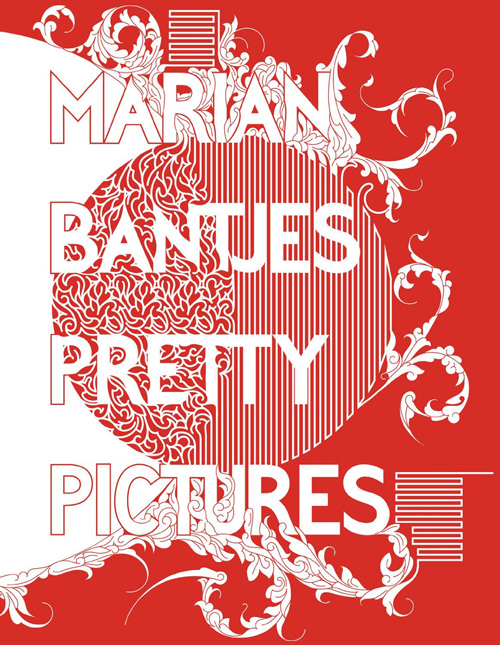 In 2010, celebrated graphic artist and designer Marian Bantjes — fairy godmother of exquisite typographic magic, whose influence so clearly reverberates through the work of such design-darling wunderkinds as Jessica Hische — gave us the glorious I Wonder. Now, Bantjes is back with Pretty Pictures (public library) — a magnificent and monumental six-pound monograph that is, of course, far more than what the irreverently literal title suggests, inviting us into a life’s-work wonderland of enchantment, beauty, thoughtfulness, opinionation, and imaginative defiance of convention.
In 2010, celebrated graphic artist and designer Marian Bantjes — fairy godmother of exquisite typographic magic, whose influence so clearly reverberates through the work of such design-darling wunderkinds as Jessica Hische — gave us the glorious I Wonder. Now, Bantjes is back with Pretty Pictures (public library) — a magnificent and monumental six-pound monograph that is, of course, far more than what the irreverently literal title suggests, inviting us into a life’s-work wonderland of enchantment, beauty, thoughtfulness, opinionation, and imaginative defiance of convention.
Reflecting on her signature style of bridging the refined elegance of the past with the exponentially evolving self-invention of the present, Bantjes, feisty as ever and capable of deploying the word “splorp” with such infinitely delightful precision, considers her own journey amidst a culture of oppressive and unimaginative fads:
I first became known for my interest in ornament and, if you will, fancy curves and elegant lines married to contemporary shapes: pixels and squares and geometric forms. I have never tried to recreate the past: the past was already done well. But I wanted to resurrect motifs that had been abandoned by modernism and the pseudo-modernist culture of contemporary design, without being nostalgic. I was at the beginning of a movement that rose like a wave and quickly crashed over us in a splorp of thoughtless ornamentation. In a way, ornamentation was undone in the 21st century by the same mechanization that undid it in the 19th. The Victorian era was known for the proliferation of a morass of printed ornament parts that were used and combined willy-nilly and to excess by mass-production printers. The neo-decorative movement of the past decade was similarly glutted by a laying-on of clipart curves, sprayed flowers and the vomit of organic shapes that poured out of digital paintbrushes. For the few of us who were genuinely interested in exploring the marriage of old and new, and in resurrecting and perfecting a purity of form, it was already too late. Curves and swirls are over, man. They were trampled in the digital, faddish stampede without so much as a glance towards quality or invention. Very few people seem to have an eye for a good curve, fewer still the ability to make one. Despite the genuine pleasure I still get in creating the loop-de-loop, I blocked off the arabesques quite soon — my interests were broader and more complex.
Known for her intricate designs of deliciously challenging legibility, Bantjes considers this a part of the creative game:
I strongly feel that if you have something of interest to say, it’s OK to make people work for it. People enjoy using their brains, figuring things out. It makes them feel triumphant when they succeed.
Bantjes offers her seven criteria for what makes desirable design:
- It should arrest and hold attention.
- It should then invoke curiosity.
- It should surprise.
- It should invoke wonder.
- It should bring joy.
- It should be memorable.
- Bonus points if it’s funny.
Echoing Debbie Millman’s assertion that “lives are shaped by chance encounters” and Steve Jobs’s famous anecdote of how he stumbled into a typography class that led him to forever change the face of computing, Bantjes recounts the serendipitous circumstances of her plunge into design — which involved walking into a second-hand bookstore to get change for the bus and encountering a small, handwritten ad for a job in a publishing company —
As an atheist, I’m not comfortable with the notion of fate, but looking back over anyone’s life, it’s possible to see those turning points, those key twists in life that turn some random act of everyday living into a crossroad.
[…]
There is no formula for success: no way to say first you do this, then that, then this. Shit happens. Shit happens to you and because of you and around you, and in the end you find yourself in some place you never expected to be.
Pretty Pictures is absolutely stunning, at once a treasure trove of visual mesmerism and a fascinating glimpse into one of the most singular, inventive, and influential minds in contemporary design.
Donating = Loving
Bringing you (ad-free) Brain Pickings takes hundreds of hours each month. If you find any joy and stimulation here, please consider becoming a Supporting Member with a recurring monthly donation of your choosing, between a cup of tea and a good dinner:
| ♥ $7 / month♥ $3 / month♥ $10 / month♥ $25 / month |
![]()
You can also become a one-time patron with a single donation in any amount:
 Brain Pickings has a free weekly newsletter. It comes out on Sundays and offers the week’s best articles. Here’s what to expect. Like? Sign up.
Brain Pickings has a free weekly newsletter. It comes out on Sundays and offers the week’s best articles. Here’s what to expect. Like? Sign up.
Brain Pickings takes 450+ hours a month to curate and edit across the different platforms, and remains banner-free. If it brings you any joy and inspiration, please consider a modest donation – it lets me know I'm doing something right.

Katerina.leznikI'd like to note that only the Knocked Up pairing is a problem for me, but it has been since the preview came out. The donkey and the dragon are MAGIC!

Katerina.leznikMARE!!!

If you're a dim sum newbie who wants to learn more about this popular style of Cantonese cuisine, check out this five-minute dim sum video guide from Off the Great Wall, a YouTube channel about Asian and Chinese culture. In the video host Carmen describes some of the most popular dim sum dishes and what to look for in a good version of each dish.
[Video: Off the Great Wall on YouTube]
(If during this video you thought, "Hey, Carmen said Worcestershire wrong," she knows—the YouTubers told her, repeatedly.)
This video is a follow-up to a video Off the Great Wall shot at Nom Wah, one of our favorite dim sum joints in NYC. Watch it below:
[Video: Off the Great Wall on YouTube]
For more descriptions of dim sum dishes, check out The Serious Eats Guide to Dim Sum.
About the author: Robyn Lee is the editor of A Hamburger Today and takes many of the photos for Serious Eats. She'll also doodle cute stuff when necessary. Read more from Robyn at her personal food blog, The Girl Who Ate Everything.
Katerina.leznikummmm this is kind of stupid. I've had short hair on and off for mos of my life and I generally receive as many weird/negative comments on it as any other hair style; and generally significantly more compliments (probably because short hair haircuts need to be cut more often and so are generally closer to the stylist's vision than long hair that has been growing out for months)
 photographed by amelia alpaugh.
Women with short hair often find themselves open to all sorts of unsolicited comments. From the backhanded compliments ("You would look so cute with longer hair!") to the passively critical questions ("Do you like it?") to those simple yet weighty observations ("You...cut your hair!"), we short-haired girls frequently find that our hair is apparently fair conversational game.
photographed by amelia alpaugh.
Women with short hair often find themselves open to all sorts of unsolicited comments. From the backhanded compliments ("You would look so cute with longer hair!") to the passively critical questions ("Do you like it?") to those simple yet weighty observations ("You...cut your hair!"), we short-haired girls frequently find that our hair is apparently fair conversational game.
“Who says they can’t handle their freedom?”
 In 1999, beloved author Toni Morrison teamed up with her son, the painter and musician Slade Morrison, and joined the ranks of other famous “adult” writers who penned lesser-known and lovely children’s stories. Together, they wrote The Big Box (public library) — the seemingly grim tale of Patty, Mickey, and Liza Sue, who are banished to live in a giant box because they “can’t handle their freedom,” having made no other transgression than the silly little disobediences and restlessnesses of which all children are “guilty.” No parents, teachers, neighbors, or fairy godmothers are there to rescue them from their cruel prison which embodies the curious duality of punishment and protection and illustrates our frequent, culturally chronic difficulty in distinguishing between the two.
In 1999, beloved author Toni Morrison teamed up with her son, the painter and musician Slade Morrison, and joined the ranks of other famous “adult” writers who penned lesser-known and lovely children’s stories. Together, they wrote The Big Box (public library) — the seemingly grim tale of Patty, Mickey, and Liza Sue, who are banished to live in a giant box because they “can’t handle their freedom,” having made no other transgression than the silly little disobediences and restlessnesses of which all children are “guilty.” No parents, teachers, neighbors, or fairy godmothers are there to rescue them from their cruel prison which embodies the curious duality of punishment and protection and illustrates our frequent, culturally chronic difficulty in distinguishing between the two.
The message, of course, is far less simplistic — the story, based on an idea Slade had when he was nine years old, which first appeared on the pages of pioneering magazine Ms. in 1980, deals with questions of morality, imaginative freedom, justice, and self-sufficiency. In the final scene, we see the three children break free of the box by their own ingenuity as the Morrisons pose the congratulatory question, “Who says they can’t handle their freedom?”
Conceptually, the book is reminiscent of Maurice Sendak’s insistence that children can handle darker, subversive themes and need not be cushioned into an artificial reality — something illustrator extraordinaire Sophie Blackall echoed in this fantastic interview. In fact, it is only recently that children’s literature became sugar-coated and euphemistic — throughout the lengthy history of children’s picture-books, from the Brothers Grim to Edward Gorey, authors have used the dark to illuminate the complexities of life.
The Big Box — the first of several such heart-warming mother-son collaborations — features art by the inimitable Giselle Potter, who went on to illustrate Gertrude Stein’s wonderful posthumously published alphabet book.
In an interview, Morrison addresses the underlying message and what the book is about:
The plight (and resistance) of children living in a wholly commercialized environment that equates “entertainment” with happiness, products with status, “things” with love, and that is terrified of the free (meaning un-commodified, unpurchaseable) imagination of the young. (Although children participate enthusiastically in the “love me so buy me” pattern, I think they are taught to think that way and that on some deep level they know what is being substituted.)
[…]
[The "box"] is a soft, familiar, comfortable, everyday “prison” into which children are metaphorically placed when their imagination is suppressed or programmed.
The children in The Big Box are surrounded by a kind of perfection — they have the newest and best toys, they are in comfortable settings with soft chairs, treats of all kinds, including a fancy television set — but much of it is fake (a jar of dirt, a butterfly under a glass, a recording of a seagull), the doors only open one way, and there are multiple locks to keep the children from getting out.
Complement The Big Box with other previously uncovered children’s gems by Mark Twain, Maya Angelou, James Joyce, Sylvia Plath, William Faulkner, Gertrude Stein, Anne Sexton, T. S. Eliot, and John Updike.
Donating = Loving
Bringing you (ad-free) Brain Pickings takes hundreds of hours each month. If you find any joy and stimulation here, please consider becoming a Supporting Member with a recurring monthly donation of your choosing, between a cup of tea and a good dinner:
| ♥ $7 / month♥ $3 / month♥ $10 / month♥ $25 / month |
![]()
You can also become a one-time patron with a single donation in any amount:
 Brain Pickings has a free weekly newsletter. It comes out on Sundays and offers the week’s best articles. Here’s what to expect. Like? Sign up.
Brain Pickings has a free weekly newsletter. It comes out on Sundays and offers the week’s best articles. Here’s what to expect. Like? Sign up.
Brain Pickings takes 450+ hours a month to curate and edit across the different platforms, and remains banner-free. If it brings you any joy and inspiration, please consider a modest donation – it lets me know I'm doing something right.


My favorite nutritional saying is: “No one ever got fat off a fruit or vegetable.”
I love this statement because it is so darn true.
We have a lot of nutritional problems in this country, but eating too many vegetables – starchy or otherwise – is not one of them.
If you’ve banished white potatoes (too starchy), beets (too much sugar), or corn (must be related to high fructose corn syrup), it’s time to reconsider. Some of the veggies with the worst reputations are actually as nutritious as the “superfoods” that get so much attention. Here are four frequently-slammed examples that don’t deserve their bad rap.
Starchy veggies like peas, corn, potatoes, etc. are also filling – kind of like whole grains – so they help make meals more satisfying without adding a lot of calories. Your best bet is to eat them (and all veggies & fruits) alongside some protein and fat.
Enjoy these beauties this summer while the picking is good!
The post Why You Should Eat Corn & Other Starchy Veggies appeared first on Eating Made Easy.
Katerina.leznikagree on sucking, and also sadness at a really iconic, ubiquitous identity getting fucked with for the worst

First produced in 1997 by Modo & Modo SpA in Milan, Moleskine — produced by the eponymous Italian parent company since 2007 — is an extensive line of pocket-sized, trusted travel companion notebooks with over 14 million units sold in around 23,000 points-of-sale, including nine branded stores, in 90 countries across the globe. Between the classic notebooks and all its variants — small, large, ruled, squared, plain, colored covers — and dozens of special editions Moleskine's collection includes over 750 products. Earlier this month Moleskine introduced a new monogram and a revised wordmark desiged by Milan-based Achilli Ghizzardi Associati.
A set of nine modules consisting of the M of Moleskine and eight rounded squares come together to form a grid, evoking the essential design elements of the Moleskine notebook with its rounded corners as well as those of the digital realm. Each module is a flexible space that can house a wealth of content: the letters of the company name, the colors and configurations of the collections, community creations and multimedia content will all fill the new Moleskine monogram.
— Press Release (PDF)

Animated GIF presenting the new logo.
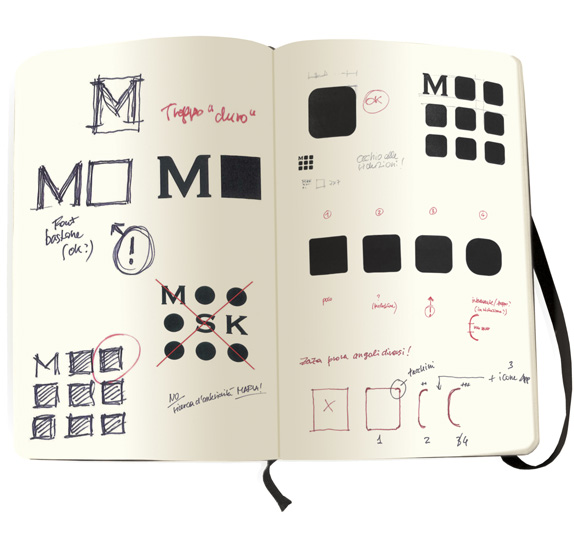
"Sketches" of the new logo. In quotes because this image couldn't be any more Photoshopped unless it had Kim Kardashian on it.
The new monogram presents the brand as designer of open platforms for creativity, communication and sharing. […] Tthe intention was to create a fluid visual icon that communicates its multi-faceted and open nature while unifying its many objects, types of users and brand values.
— Press Release (PDF)

Monogram detail, above. With stuff, below.
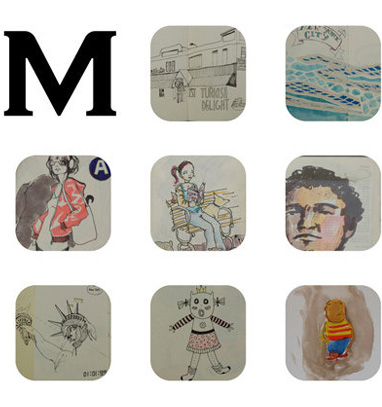
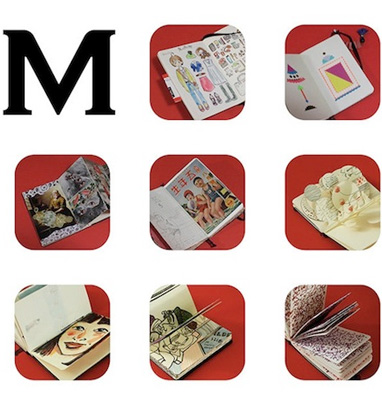
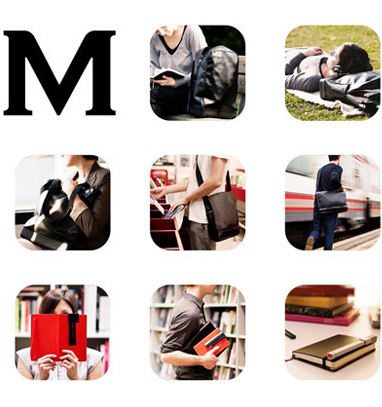
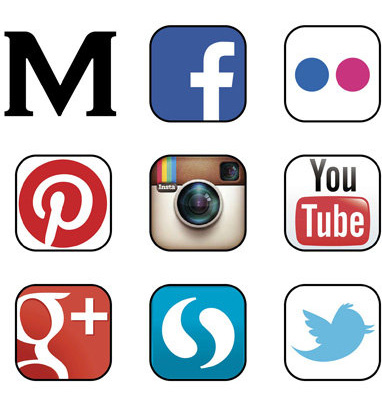
Re: the above image. Shoot me now.
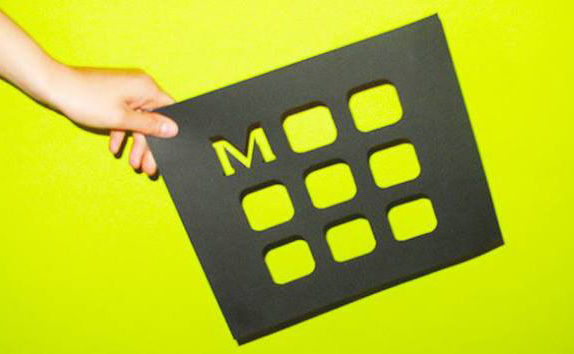
The logotype remains unchanged apart from a more emphasized roundness to the curves of the letters, creating a proprietary font for the first time in the company's history. Particular attention has been given to the letter M, which becomes the pivot for the whole visual identity.
— Press Release (PDF)

Detail of the wordmark. Apologies for fuzziness, it's the best I could find.
If it were designed today, I would vehemently complain about the old wordmark being set in the overused and underwhelming Copperplate Gothic but, now, compared to the atrocious update to it, I find the simplicity and established ubiquity of the old one a major loss. The new wordmark takes out all the edge and crispness of the old and sands down every corner down to a stubby soft corner, while getting rid of inward serifs that provided necessary balance. A major downgrade. Then there is the new monogram, that takes the new "M" and places eight rounded squares (that mimic the rounded corners of the notebooks, see?) around to create a 3-by-3 grid. It's not totally a bad idea, but why squares? As far as I can tell, there isn't a single square Moleskine out there and it's not like every logo should replicate its product or history but the disconnect here is quite obvious and flawed. The monogram then uses the logo-as-window in the most obvious and boring ways, kind of ruining that maneuver for the rest of us. Finally, the monogram is used in tandem with the new wordmark, where it becomes so small to be unreadable. Overall, a very disappointing evolution, specially considering the product's popularity and embrace in creative industries. It deserved better.
Thanks to Yotam Hadar for first tip.


Katerina.lezniksorry for 2 brain pickings shares in 1 day, but george's list is pretty hilarious
“Labour to keep alive in your breast that little spark of celestial fire called conscience.”
 “The list is the origin of culture,” Umberto Eco proclaimed. “I perceive value, I confer value, I create value, I even create — or guarantee — existence. Hence, my compulsion to make ‘lists,’” Susan Sontag reflected. But one of modern history’s greatest list-lovers was none other than America’s first President. In 1745, coming up on his fifteenth year, young George Washington penned a list of 110 commandments for cultivating character, titled Rules of Civility & Decent Behaviour In Company and Conversation and digitally preserved by the University of Virginia Archives.
“The list is the origin of culture,” Umberto Eco proclaimed. “I perceive value, I confer value, I create value, I even create — or guarantee — existence. Hence, my compulsion to make ‘lists,’” Susan Sontag reflected. But one of modern history’s greatest list-lovers was none other than America’s first President. In 1745, coming up on his fifteenth year, young George Washington penned a list of 110 commandments for cultivating character, titled Rules of Civility & Decent Behaviour In Company and Conversation and digitally preserved by the University of Virginia Archives.
Even though in his 1890 book George Washington’s Rules of Civility Traced to Their Sources and Restored Moncure Daniel Conway notes that Washington generously “borrowed” the bulk of his rules from a 1595 French Jesuit book — a testament to the fact that everything builds on what came before — they remain fascinating in their own right as an ideological predecessor to the foundation of America’s democratic and moral ideals.
Some, at the intersection of the dated and the timeless, expose the parallel progress of cultural conventions and technology: For instance, Washington admonishes against reading “letters, books, or papers in company” — the then-equivalent of looking at your iPhone during a dinner party. Some speak to the enduring importance of critical thinking: “Be not hasty to beleive flying Reports to the Disparag[e]ment of any.” Some advocate for the humanizing effect of compassion: “When you see a Crime punished, you may be inwardly Pleased; but always shew Pity to the Suffering Offender.” Some remind us of how our personal micro-culture shapes us: “Associate yourself with Men of good Quality if you Esteem your own Reputation; for ’tis better to be alone than in bad Company.”
Transcript below, with teenage George’s original typos (long before “typing” as we know it, of course) preserved.
- Every Action done in Company, ought to be with Some Sign of Respect, to those that are Present.
- When in Company, put not your Hands to any Part of the Body, not usualy Discovered.
- Shew Nothing to your Freind that may affright him.
- In the Presence of Others Sing not to yourself with a humming Noise, nor Drum with your Fingers or Feet.
- If You Cough, Sneeze, Sigh, or Yawn, do it not Loud but Privately; and Speak not in your Yawning, but put Your handkercheif or Hand before your face and turn aside.
- Sleep not when others Speak, Sit not when others stand, Speak not when you Should hold your Peace, walk not on when others Stop.
- Put not off your Cloths in the presence of Others, nor go out your Chamber half Drest.
- At Play and at Fire its Good manners to Give Place to the last Commer, and affect not to Speak Louder than Ordinary.
- Spit not in the Fire, nor Stoop low before it neither Put your Hands into the Flames to warm them, nor Set your Feet upon the Fire especially if there be meat before it.
- When you Sit down, Keep your Feet firm and Even, without putting one on the other or Crossing them.
- Shift not yourself in the Sight of others nor Gnaw your nails.
- Shake not the head, Feet, or Legs rowl not the Eys lift not one eyebrow higher than the other wry not the mouth, and bedew no mans face with your Spittle, by appr[oaching too nea]r him [when] you Speak.
- Kill no Vermin as Fleas, lice ticks &c in the Sight of Others, if you See any filth or thick Spittle put your foot Dexteriously upon it if it be upon the Cloths of your Companions, Put it off privately, and if it be upon your own Cloths return Thanks to him who puts it off.
- Turn not your Back to others especially in Speaking, Jog not the Table or Desk on which Another reads or writes, lean not upon any one.
- Keep your Nails clean and Short, also your Hands and Teeth Clean yet without Shewing any great Concern for them.
- Do not Puff up the Cheeks, Loll not out the tongue rub the Hands, or beard, thrust out the lips, or bite them or keep the Lips too open or too Close.
- Be no Flatterer, neither Play with any that delights not to be Play’d Withal.
- Read no Letters, Books, or Papers in Company but when there is a Necessity for the doing of it you must ask leave: come not near the Books or Writings of Another so as to read them unless desired or give your opinion of them unask’d also look not nigh when another is writing a Letter.
- let your Countenance be pleasant but in Serious Matters Somewhat grave.
- The Gestures of the Body must be Suited to the discourse you are upon.
- Reproach none for the Infirmaties of Nature, nor Delight to Put them that have in mind thereof.
- Shew not yourself glad at the Misfortune of another though he were your enemy.
- When you see a Crime punished, you may be inwardly Pleased; but always shew Pity to the Suffering Offender.
- [Do not laugh too loud or] too much at any Publick [Spectacle].
- Superfluous Complements and all Affectation of Ceremonie are to be avoided, yet where due they are not to be Neglected.
- In Pulling off your Hat to Persons of Distinction, as Noblemen, Justices, Churchmen &c make a Reverence, bowing more or less according to the Custom of the Better Bred, and Quality of the Person. Amongst your equals expect not always that they Should begin with you first, but to Pull off the Hat when there is no need is Affectation, in the Manner of Saluting and resaluting in words keep to the most usual Custom.
- Tis ill manners to bid one more eminent than yourself be covered as well as not to do it to whom it’s due Likewise he that makes too much haste to Put on his hat does not well, yet he ought to Put it on at the first, or at most the Second time of being ask’d; now what is herein Spoken, of Qualification in behaviour in Saluting, ought also to be observed in taking of Place, and Sitting down for ceremonies without Bounds is troublesome.
- If any one come to Speak to you while you are are Sitting Stand up tho he be your Inferiour, and when you Present Seats let it be to every one according to his Degree.
- When you meet with one of Greater Quality than yourself, Stop, and retire especially if it be at a Door or any Straight place to give way for him to Pass.
- In walking the highest Place in most Countrys Seems to be on the right hand therefore Place yourself on the left of him whom you desire to Honour: but if three walk together the mid[dest] Place is the most Honourable the wall is usually given to the most worthy if two walk together.
- If any one far Surpassess others, either in age, Estate, or Merit [yet] would give Place to a meaner than hims[elf in his own lodging or elsewhere] the one ought not to except it, S[o he on the other part should not use much earnestness nor offer] it above once or twice.
- To one that is your equal, or not much inferior you are to give the cheif Place in your Lodging and he to who ’tis offered ought at the first to refuse it but at the Second to accept though not without acknowledging his own unworthiness.
- They that are in Dignity or in office have in all places Preceedency but whilst they are Young they ought to respect those that are their equals in Birth or other Qualitys, though they have no Publick charge.
- It is good Manners to prefer them to whom we Speak befo[re] ourselves especially if they be above us with whom in no Sort we ought to begin.
- Let your Discourse with Men of Business be Short and Comprehensive.
- Artificers & Persons of low Degree ought not to use many ceremonies to Lords, or Others of high Degree but Respect and high[ly] Honour them, and those of high Degree ought to treat them with affibility & Courtesie, without Arrogancy.
- In Speaking to men of Quality do not lean nor Look them full in the Face, nor approach too near them at lest Keep a full Pace from them.
- In visiting the Sick, do not Presently play the Physicion if you be not Knowing therein.
- In writing or Speaking, give to every Person his due Title According to his Degree & the Custom of the Place.
- Strive not with your Superiers in argument, but always Submit your Judgment to others with Modesty.
- Undertake not to Teach your equal in the art himself Proffesses; it Savours of arrogancy.
- [Let thy ceremonies in] Courtesie be proper to the Dignity of his place [with whom thou conversest for it is absurd to ac]t the same with a Clown and a Prince.
- Do not express Joy before one sick or in pain for that contrary Passion will aggravate his Misery.
- When a man does all he can though it Succeeds not well blame not him that did it.
- Being to advise or reprehend any one, consider whether it ought to be in publick or in Private; presently, or at Some other time in what terms to do it & in reproving Shew no Sign of Cholar but do it with all Sweetness and Mildness.
- Take all Admonitions thankfully in what Time or Place Soever given but afterwards not being culpable take a Time [&] Place convenient to let him him know it that gave them.
- Mock not nor Jest at any thing of Importance break [n]o Jest that are Sharp Biting and if you Deliver any thing witty and Pleasent abtain from Laughing thereat yourself.
- Wherein wherein you reprove Another be unblameable yourself; for example is more prevalent than Precepts.
- Use no Reproachfull Language against any one neither Curse nor Revile.
- Be not hasty to beleive flying Reports to the Disparag[e]ment of any.
- Wear not your Cloths, foul, unript or Dusty but See they be Brush’d once every day at least and take heed tha[t] you approach not to any Uncleaness.
- In your Apparel be Modest and endeavour to accomodate Nature, rather than to procure Admiration keep to the Fashio[n] of your equals Such as are Civil and orderly with respect to Times and Places.
- Run not in the Streets, neither go t[oo s]lowly nor wit[h] Mouth open go not Shaking yr Arms [kick not the earth with yr feet, go] not upon the Toes, nor in a Dancing [fashion].
- Play not the Peacock, looking every where about you, to See if you be well Deck’t, if your Shoes fit well if your Stokings sit neatly, and Cloths handsomely.
- Eat not in the Streets, nor in the House, out of Season.
- Associate yourself with Men of good Quality if you Esteem your own Reputation; for ’tis better to be alone than in bad Company.
- In walking up and Down in a House, only with One in Compan[y] if he be Greater than yourself, at the first give him the Right hand and Stop not till he does and be not the first that turns, and when you do turn let it be with your face towards him, if he be a Man of Great Quality, walk not with him Cheek by Joul but Somewhat behind him; but yet in Such a Manner that he may easily Speak to you.
- Let your Conversation be without Malice or Envy, for ’tis a Sig[n o]f a Tractable and Commendable Nature: And in all Causes of Passion [ad]mit Reason to Govern.
- Never express anything unbecoming, nor Act agst the Rules Mora[l] before your inferiours.
- Be not immodest in urging your Freinds to Discover a Secret.
- Utter not base and frivilous things amongst grave and Learn’d Men nor very Difficult Questians or Subjects, among the Ignorant or things hard to be believed, Stuff not your Discourse with Sentences amongst your Betters nor Equals.
- Speak not of doleful Things in a Time of Mirth or at the Table; Speak not of Melancholy Things as Death and Wounds, and if others Mention them Change if you can the Discourse tell not your Dreams, but to your intimate Friend.
- A Man o[ug]ht not to value himself of his Atchievements, or rare Qua[lities of wit; much less of his rich]es Virtue or Kindred.
- Break not a Jest where none take pleasure in mirth Laugh not aloud, nor at all without Occasion, deride no mans Misfortune, tho’ there Seem to be Some cause.
- Speak not injurious Words neither in Jest nor Earnest Scoff at none although they give Occasion.
- Be not froward but friendly and Courteous; the first to Salute hear and answer & be not Pensive when it’s a time to Converse.
- Detract not from others neither be excessive in Commanding.
- Go not thither, where you know not, whether you Shall be Welcome or not. Give not Advice with[out] being Ask’d & when desired [d]o it briefly.
- If two contend together take not the part of either unconstrain[ed]; and be not obstinate in your own Opinion, in Things indiferent be of the Major Side.
- Reprehend not the imperfections of others for that belong[s] to Parents Masters and Superiours.
- Gaze not on the marks or blemishes of Others and ask not how they came. What you may Speak in Secret to your Friend deliver not before others.
- Speak not in an unknown Tongue in Company but in your own Language and that as those of Quality do and not as the Vulgar; Sublime matters treat Seriously.
- Think before you Speak pronounce not imperfectly nor bring ou[t] your Words too hastily but orderly & distinctly.
- When Another Speaks be attentive your Self and disturb not the Audience if any hesitate in his Words help him not nor Prompt him without desired, Interrupt him not, nor Answer him till his Speec[h] be ended.
- In the midst of Discourse ask [not of what one treateth] but if you Perceive any Stop because of [your coming you may well intreat him gently] to Proceed: If a Person of Quality comes in while your Conversing it’s handsome to Repeat what was said before.
- While you are talking, Point not with your Finger at him of Whom you Discourse nor Approach too near him to whom you talk especially to his face.
- Treat with men at fit Times about Business & Whisper not in the Company of Others.
- Make no Comparisons and if any of the Company be Commended for any brave act of Vertue, commend not another for the Same.
- Be not apt to relate News if you know not the truth thereof. In Discoursing of things you Have heard Name not your Author always A [Se]cret Discover not.
- Be not Tedious in Discourse or in reading unless you find the Company pleased therewith.
- Be not Curious to Know the Affairs of Others neither approach those that Speak in Private.
- Undertake not what you cannot Perform but be Carefull to keep your Promise.
- When you deliver a matter do it without Passion & with Discretion, howev[er] mean the Person be you do it too.
- When your Superiours talk to any Body hearken not neither Speak nor Laugh.
- In Company of these of Higher Quality than yourself Speak not ti[l] you are ask’d a Question then Stand upright put of your Hat & Answer in few words.
- In Disputes, be not So Desireous to Overcome as not to give Liberty to each one to deliver his Opinion and Submit to the Judgment of the Major Part especially if they are Judges of the Dispute.
- [Let thy carriage be such] as becomes a Man Grave Settled and attentive [to that which is spoken. Contra]dict not at every turn what others Say.
- Be not tedious in Discourse, make not many Digressigns, nor rep[eat] often the Same manner of Discourse.
- Speak not Evil of the absent for it is unjust.
- Being Set at meat Scratch not neither Spit Cough or blow your Nose except there’s a Necessity for it.
- Make no Shew of taking great Delight in your Victuals, Feed no[t] with Greediness; cut your Bread with a Knife, lean not on the Table neither find fault with what you Eat.
- Take no Salt or cut Bread with your Knife Greasy.
- Entertaining any one at table it is decent to present him wt. meat, Undertake not to help others undesired by the Master.
- If you Soak bread in the Sauce let it be no more than what you [pu]t in your Mouth at a time and blow not your broth at Table [bu]t Stay till Cools of it Self.
- Put not your meat to your Mouth with your Knife in your ha[nd ne]ither Spit forth the Stones of any fruit Pye upon a Dish nor Cas[t an]ything under the table.
- It’s unbecoming to Stoop much to ones Meat Keep your Fingers clea[n &] when foul wipe them on a Corner of your Table Napkin.
- Put not another bit into your Mouth til the former be Swallowed [l]et not your Morsels be too big for the Gowls.
- Drink not nor talk with your mouth full neither Gaze about you while you are a Drinking.
- Drink not too leisurely nor yet too hastily.Before and after Drinking wipe your Lips breath not then or Ever with too Great a Noise, for its uncivil.
- Cleanse not your teeth with the Table Cloth Napkin Fork or Knife but if Others do it let it be done wt.
a Pick Tooth.
- Rince not your Mouth in the Presence of Others.
- It is out of use to call upon the Company often to Eat nor need you Drink to others every Time you Drink.
- In Company of your Betters be no[t longer in eating] than they are lay not your Arm but o[nly your hand upon the table].
- It belongs to the Chiefest in Company to unfold his Napkin and fall to Meat first, But he ought then to Begin in time & to Dispatch [w]ith Dexterity that the Slowest may have time allowed him.
- Be not Angry at Table whatever happens & if you have reason to be so, Shew it not but on a Chearfull Countenance especially if there be Strangers for Good Humour makes one Dish of Meat a Feas[t].
- Set not yourself at the upper of the Table but if it Be your Due or that the Master of the house will have it So, Contend not, least you Should Trouble the Company.
- If others talk at Table be attentive but talk not with Meat in your Mouth.
- When you Speak of God or his Atributes, let it be Seriously & [wt.] Reverence.
Honour & Obey your Natural Parents altho they be Poor.
- Let your Recreations be Manfull not Sinfull.
- Labour to keep alive in your Breast that Little Spark of Ce[les]tial fire Called Conscience.
Finis
Complement Rules of Civility & Decent Behaviour In Company and Conversation with this timeless 1866 guide to the art of conversation.
Thanks, Cojourneo
Donating = Loving
Bringing you (ad-free) Brain Pickings takes hundreds of hours each month. If you find any joy and stimulation here, please consider becoming a Supporting Member with a recurring monthly donation of your choosing, between a cup of tea and a good dinner:
| ♥ $7 / month♥ $3 / month♥ $10 / month♥ $25 / month |
![]()
You can also become a one-time patron with a single donation in any amount:
 Brain Pickings has a free weekly newsletter. It comes out on Sundays and offers the week’s best articles. Here’s what to expect. Like? Sign up.
Brain Pickings has a free weekly newsletter. It comes out on Sundays and offers the week’s best articles. Here’s what to expect. Like? Sign up.
Brain Pickings takes 450+ hours a month to curate and edit across the different platforms, and remains banner-free. If it brings you any joy and inspiration, please consider a modest donation – it lets me know I'm doing something right.

“There were no openly gay policemen, public school teachers, doctors, or lawyers.”
 In the early morning hours of June 28, 1969, violent protests and street demonstrations took over the streets of New York after a police raid of Stonewall Inn, the now-legendary Greenwich Village gay bar. Known as the Stonewall Riots, these protests are commonly considered the tipping point at which the LGBT community coalesced into political cohesion and the birth of the modern gay rights movement. On that June morning, equality for all seemed a distant but necessary dream — a dream that has finally become reality a day shy of 44 years later.
In the early morning hours of June 28, 1969, violent protests and street demonstrations took over the streets of New York after a police raid of Stonewall Inn, the now-legendary Greenwich Village gay bar. Known as the Stonewall Riots, these protests are commonly considered the tipping point at which the LGBT community coalesced into political cohesion and the birth of the modern gay rights movement. On that June morning, equality for all seemed a distant but necessary dream — a dream that has finally become reality a day shy of 44 years later.
In Stonewall: The Riots That Sparked the Gay Revolution (public library), David Carter contextualizes the remarkable delta of progress that the Stonewall Riots precipitated:
It was only a few decades ago — a very short time in historical terms — that the situation of gay men and lesbians was radically different from what it is today. At the end of the 1960s, homosexual sex was illegal in every state but Illinois. Not one law — federal, state, or local — protected gay men or women from being fired or denied housing. There were no openly gay politicians. No television show had any identifiably gay characters. When Hollywood made a film with a major homosexual character, the character was either killed or killed himself. There were no openly gay policemen, public school teachers, doctors, or lawyers. And no political party had a gay caucus.
In 1970, to mark the first anniversary of the Stonewall uprisings, the very first Gay Pride marches took place in New York, Los Angeles, San Francisco, and Chicago.
Digging through the New York Public Library archives, I unearthed some goosebump-inducing photos of the first-ever Pride parades around the world:

New York City Gay Liberation Day, Christopher Street, June 27, 1970 (Photograph: Diana Davies via NYPL)

Gay Liberation Day march and dance, New York City, June 27, 1970 (Photograph: Kay Tobin Lahusen via NYPL)

New York City Gay Liberation Day, Christopher Street, June 27, 1970 (Photograph: Diana Davies via NYPL)
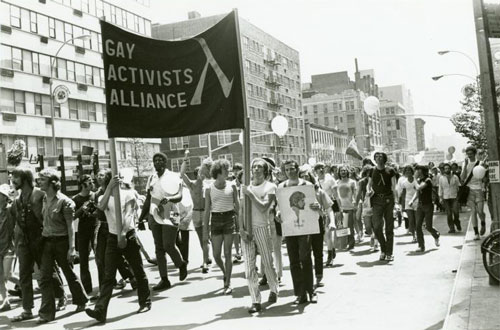
Gay Liberation Day march and dance, New York City, June 27, 1970 (Photograph: Barbara Gittings and Kay Tobin Lahusen via NYPL)

Gay Liberation Day march and dance, New York City, June 27, 1970 (Photograph: Barbara Gittings and Kay Tobin Lahusen via NYPL)

Philadelphia's first Gay Pride rally and march, June 11, 1972 (Photograph: Kay Tobin Lahusen via NYPL)

Annapolis students at Philadelphia's first Gay Pride rally, 1972 (Photograph: Kay Tobin Lahusen via NYPL)

Lesbian couple at Toronto's first Gay Pride Week, August 1972 (Photograph: Kay Tobin Lahusen via NYPL)
For the complete cultural context on this tidal change, Stonewall: The Riots That Sparked the Gay Revolution is indispensable in its entirety.
Donating = Loving
Bringing you (ad-free) Brain Pickings takes hundreds of hours each month. If you find any joy and stimulation here, please consider becoming a Supporting Member with a recurring monthly donation of your choosing, between a cup of tea and a good dinner:
| ♥ $7 / month♥ $3 / month♥ $10 / month♥ $25 / month |
![]()
You can also become a one-time patron with a single donation in any amount:
 Brain Pickings has a free weekly newsletter. It comes out on Sundays and offers the week’s best articles. Here’s what to expect. Like? Sign up.
Brain Pickings has a free weekly newsletter. It comes out on Sundays and offers the week’s best articles. Here’s what to expect. Like? Sign up.
Brain Pickings takes 450+ hours a month to curate and edit across the different platforms, and remains banner-free. If it brings you any joy and inspiration, please consider a modest donation – it lets me know I'm doing something right.


A plate of lamb and green squash dumplings. [Photographs: Max Falkowitz]
There many dumplings worth seeking out in Flushing, but only one that I get every time I visit. It doesn't matter what else I've come for—breakfast, tea shopping, a 12-course meal somewhere else—the dumplings are non-negotiable.
I've planned my wardrobe accordingly. No white ever. No light colors at all, actually; these dumplings are spurters, and I want to hide the stains.
These are the Lamb and Green Squash dumplings from Tianjin Dumpling House, a princely $5 for a plate of 12, and they are, bar-none, my favorite dumplings in the city.

Tianjin Dumpling is a dinky little stall in the basement of the Golden Shopping Mall, a food court on Main Street that may be home to Flushing's highest concentration of good eating. It's cramped down there, a little noisy, and the air is redolent of chili oil and starchy steam, the vapors of dozens of noodle and dumpling pots boiling away.
The stall occupies prime corner real estate in the middle of the basement food court's corridors, though you'll miss the red sign if you're not looking for it. Instead, keep an eye out for the counter of plump dumplings wrapped in taut doughs, ready to be boiled to order (they don't steam or fry here). There's the lamb and squash. Alongside it are beef and turnip, chicken and broccoli, seabass. Wait, what? "I make up my own dumplings based on my customer's needs," says Lily, the friendly woman at the stall who, by my experience, is your best bet for any English conversation. Tianjin Dumpling does conventional fillings too, but it's these specialties that set the stall apart.

The lamb filling.
I've enjoyed every one I've tried, but those lamb dumplings are in a class by themselves. The skins are thin and delicate, chewier than wontons but only slightly. The filling is self-saucing: a lipsmackingly rich mix of finely ground lamb, ever so slightly gamey, tempered by the sweetness of summer squash and scallion. They finish clean, not greasy, though if you want to oil them up, a tub of housemade chili oil is ready to help, not that they need any fiddling.

Vegetable filling.
There's also the best vegetable dumplings I've ever had, the same soft, supple skins enclosing bunches of vermicelli noodles, scrambled egg, and funky garlic chive ($3 for 12). They're rich and satisfying in a way that so few vegetarian dumplings are; if you like them, you can find a similar filling in the larger griddled pancakes at Tianjin's sister stall upstairs.

The dumpling counter.
The other flavors are worth your time, like a pork, shrimp, and chive that beats the pants off any dollar dumpling joint in Manhattan, or beef and turnip, a subtler but resoundingly hearty combination. But I can't say I've strayed too far from my lamb order. I haven't had to.
Dumplings are only half this stall's business; around the corner there's a cold appetizer display with everything from smashed cucumbers and shredded potatoes to animal heads, hearts, trotters, and fatty, smoky northern Chinese sausages. Customers frequently order these to go; the chili-slicked potatoes, cucumbers, and marinated tofu have all treated me well, and if you stir them up together at home with some black vinegar, you have the makings of a fine salad.

Cold appetizers.
You can also order dumplings to go, frozen in packs of 25 or 50. Those lamb dumplings cost a mere $14 for 50, and my freezer is rarely without them. Boil them for 10 minutes, or better yet, steam them to bring out the full delicacy of the skins; Lily points out they'd steam them if they could.

Marinated tofu, sliced and slicked with chili oil.
But I'll warn you, buying frozen dumplings is habit forming. Take the customer from Port Washington I met on my first visit, as she was ordering a round 100 for a party that evening. "How often do you come here?" I asked.
"Well, when I got here, they said, 'Wow, we didn't see you last weekend! We were worried.'"
About the author: Max Falkowitz is the editor of Serious Eats: New York. You can follow him on Twitter at @maxfalkowitz.
Katerina.leznikSky, check out the description of #5
Gone are the days of the hardcover book filled with guests' good wishes that you proudly display on your coffee table... and likely never open. Couples are finding new ways of commemorating their wedding day with personal — and personalized — objects they can incorporate into their home and enjoy every day.
Katerina.leznikI think lifestyle inflation is a major struggle for most people I know (including myself) ... just sifting through all the expenses that you add into your life as you start to be able to afford it (higher rent, more take-out, going out, more travel, cleaning or laundry services, etc) and consistently taking stock of which of these things are actually increasing your quality of life and which just seem convenient but are actually robbing you of money you'd rather spend differently now or in the future...
This post is from staff writer Kristin Wong.
When I think of lifestyle inflation, I think of going to my favorite sushi restaurant every weekend. I think of buying the pricey cashmere sweater I’ve been eyeing and then buying ten more expensive sweaters. I think of spending weekends on yachts and drinking champagne while a guy on a violin serenades me. Well, scratch that last one, because I get seasick, but yeah. I think of lifestyle inflation as being along those fancy lines.
But sometimes it isn’t fancy at all. Sometimes lifestyle inflation is just little things that add up. And sometimes, those little things aren’t even fun or enjoyable.
Here are some boring examples of my own lifestyle inflation.
If getting older isn’t depressing enough, when I turned 30 in April, my health insurance premium increased by $20 a month.
I’m joking about aging being depressing (bring it on), but the price hike was frustrating.
For Los Angeles, Brian and I pay a modest amount in rent, especially considering both our location and our view. So when the landlady told us our rent was increasing by three percent, I was disappointed, but I also knew it was still a good deal overall. Plus, the inflation was expected when our original lease expired.
But this three percent increase still equates to an extra $40 a month, or $20 each. Between this and my health insurance premium, my budget has now increased by $40 a month.
For my freelance work, I need to use a specific video-editing program, and that program costs $20 a month. Sure, I can write it off, but I’m still paying more than my budget has anticipated. And that budget is now at about $60 extra per month.
This expense was my light bulb moment.
Upon paying for it, I groaned, and then I thought, “Well, why else do I work hard for my money if not to be able to shrug off a measly twenty bucks a month?”
I stopped myself, realizing I’d used the same thought process about the health insurance and rent increase.
“Wait. That’s how lifestyle inflation creeps up on you!” I thought. “And it’s not even fun!”
Sure, I’m glad I have health insurance. But I wouldn’t say I’m enjoying it. I’m glad to have work that requires using that editing software. I wouldn’t say I use it for fun.
I guess sometimes an inflated lifestyle is simply accepting budget inflation without doing anything about it. And hey, that’s okay! Because it’s inevitable — prices go up, and there’s only so much we can do about that.
Also, lifestyle inflation gets a bad rap, but it’s why lots of us want to get rich in the first place. We want to be comfortable enough to not worry about a little inflation — things like a good insurance plan increasing by ten bucks a month. Lifestyle inflation isn’t just about having fun on yachts, it’s also about not fretting so much over inflation itself.
But I’m not quite there yet. I still have ambitious savings goals; I still have reasons for wanting to maintain my budget. And sure, I may not be able to help some areas of my life from getting more expensive, but I’ve been working on finding ways to maintain my overall budget. That means cutting back in other areas.
I haven’t been living like a pauper. Over the past year, I’ve deliberately given myself the financial elbowroom to enjoy some things, and that’s great. It falls in line with the Get Rich Slowly philosophy. But, for me, it’s time to bring it back a little bit. Simply put, I’m not ready for lifestyle inflation.
Earning more is a necessary part of getting rich slowly; it’s not enough to just save. The formula works best when you earn more and maintain your same lifestyle. But earning more to catch up to a lifestyle that’s already increased feels like doing it backwards.
Just like it’s not enough to save without earning more, I don’t feel like it’s enough to just earn more and not save. Making more money is the obvious way to counteract my lifestyle inflation, but ideally, I’d like to deflate my lifestyle, too.
And there’s another hitch: I don’t have a lot of free time. I’m thankful that I have the option of taking on more work if I want it, but right now, my weekends are more precious, and I’d rather cut back on expenditures than cut back on that free time. So here are a couple of simple ways I’ve cut back to counteract that extra $60 a month.
A couple of times now, I’ve started on a load of laundry only to realize I don’t have enough quarters to put them in the dryer. That means hang drying them on my deck. “What are you, a cavewoman?” a friend teased. But hang drying my laundry doesn’t take much more time and effort, and if I do it every time, it’s cheaper to the tune of about $10 a month. It’s a small amount, but it makes me feel a little bit better about that extra $60.
I’m sure at some point, I’ll go back to the luxurious convenience putting my clothes in the dryer. Probably in the wintertime, when it’s cold and I want a pile of something warm to jump into. And then, yes, my lifestyle will once again inflate by ten dollars a month. But at least that’ll be my own doing.
Lifestyle deflation
My main source of entertainment is going out to eat. I don’t know what it is; I just love it. I get more excited about the anticipation of restaurant food than most people do. When the waiter brings my plate, I literally applaud at the table. Yes, I realize dining out isn’t typically frugal, but this is my thing. I don’t go to concerts or the movies much. The large majority of my entertainment budget goes to sushi.
Brian and I typically go out to eat, just the two of us, on Friday nights, and it’s something I look forward to all week long. It celebrates our hard work during the week, and it’s also our date night. But if I want to deflate my lifestyle, this treat is going to have to be tweaked. If I stay home just one Friday night out of the month, I’ll save $30-$40.
Cutting back even just a little bit, I’m able to offset my lifestyle inflation by $50. Thus, my lifestyle has now only inflated by $10 a month. That’s $120 a year — still an increase, but better than $720.
I could probably cut back more, but at some point, it’s about balance. Yes, I want to save up, but I want to enjoy my financial freedom, too. Giving yourself some elbowroom often leads to lifestyle inflation, but I suppose that’s when you have to set a boundary and draw a line. Apparently, mine starts at $60 a month.
“So the point of this article is to air dry your laundry and not eat so much sushi?” Yep, pretty much. But the point is also that little things add up. And that can work just as well in your favor as it can against you.
A premium hike here and rent increase there can fatten your budget quite a bit without you even realizing it. But cutting back, even just a little bit, has the same effect.
Katerina.leznikdayumn
 Image via tfcornerstone.comOne of my favorite things to do in the summer is see outdoor free movies. I love getting together with a bunch of friends, cramming onto a picnic blanket, eating junk food, and watching some movie we’ve seen 100 times before. It’s one of those summertime essential activities for me – if I don’t get to at least one, I feel like I’ve missed out on truly experiencing summer in the city.
Image via tfcornerstone.comOne of my favorite things to do in the summer is see outdoor free movies. I love getting together with a bunch of friends, cramming onto a picnic blanket, eating junk food, and watching some movie we’ve seen 100 times before. It’s one of those summertime essential activities for me – if I don’t get to at least one, I feel like I’ve missed out on truly experiencing summer in the city.
But I can’t tell you how many movies I’ve missed due to simply not placing the goddamn movie schedule on my calendar. It happens to me every year! I’ll remember a certain movie was playing at Brooklyn Bridge Park that I wanted to see, and I’ll check the date and it’ll have played the week before. Or I’ll see on Twitter that everyone is talking about the movie at Coney Island I wanted to go see. Meanwhile, I’m sitting in my office, working late to take advantage of the free air-conditioning.
So this year, I’m being a bit proactive. I searched the internet high and low and put together a master schedule of (most of) the free movies playing in the city this year. (Sorry Queens – as cool as your Socrates Sculpture Park films sound, I’m never going up there).
Below, you’ll find the monthly grids, organized by date, title, and location. Links to the individual sites (with their official program names) can be found below too, so be sure to peruse those for times and cancellations and whatnot. Oh, and some of the festivals (Central Park Conservatory Film Festival, SummerScreen, etc) actually allow you to vote for what film you want to see. I’ve listed all the options, but you’ll want to check which one makes the cut eventually (or vote yourself if you give a shit).
Hope this helps!



Central Park Conservancy Film Festival: Landscape between Sheep Meadow and the 72nd Street Cross Drive. Voting ends June 23.
Coney Island Flicks on the Beach: Coney Island, W. 10th Street
East River State Park: Williamsburg
Films on the Green: Various Parks
Films in Tompkins: Tompkins Square Park
HBO Bryant Park Summer Film Festival: Bryant Park
Intrepid Summer Movie Series: Pier 86
Movies Under the Stars: Pier 1 in Riverside Park South
Red Hook Flicks: Valentino Pier
RiverFlicks for Grown-Ups: Pier 63 Lawn in Chelsea
RiverFlicks for Kids: Pier 46 in Greenwich Village
SummerScreen: McCarren Park, Williamsburg
Syfy Movies With A View: Brooklyn Bridge Park Pier 1
Katerina.leznikok let's see if this sharing thing works ... can anyone else see one of these kids moving in here in the future, when they drop out of their business fails or something?
I'm willing to stake my reputation on the claim that this treehouse is the most amazing kids' treehouse. Ever.
Grandparents Steve and Jeri Wakefield hired an architect to build the structure for their grandchildren, and now even the neighborhood kids get to enjoy it. Read more about their labor of love after the jump!
More“What art does … is tell us, make us feel that what we think we know, we don’t.”
 However skeptical one might be of formal education, one of its great traditions remains the art of the stirring graduation speech. At the 2013 commencement ceremony for the graduating class of New York’s School of Visual Arts — which rounds out creative culture with such diverse programs as Design Criticism, Computer Arts, Animation, and Visual Effects, and the country’s only Masters in Branding degree — cultural critic and prolific author Greil Marcus delivers an absolutely remarkable commencement address that captures everything that’s wrong about our divisive high/low model of culture and all the hope that art, at its heart, gives for bridging this divide by speaking to the most profound depths of the human psyche:
However skeptical one might be of formal education, one of its great traditions remains the art of the stirring graduation speech. At the 2013 commencement ceremony for the graduating class of New York’s School of Visual Arts — which rounds out creative culture with such diverse programs as Design Criticism, Computer Arts, Animation, and Visual Effects, and the country’s only Masters in Branding degree — cultural critic and prolific author Greil Marcus delivers an absolutely remarkable commencement address that captures everything that’s wrong about our divisive high/low model of culture and all the hope that art, at its heart, gives for bridging this divide by speaking to the most profound depths of the human psyche:
Echoing Perry Meisel’s defiance of “high” vs. “low” culture, Marcus argues:
I’ve always believed that the divisions between high art and low art, between high culture, which really ought to be called “sanctified culture,” and what’s sometimes called popular culture, but really ought to be called “everyday culture” — the culture of anyone’s everyday life, the music I listen to, the movies you see, the advertisements that infuriate us and that sometimes we find so thrilling, so moving — I’ve always believed that these divisions are false. And, as a result of trying to make that argument over the years, I’ve also come to believe that these divisions are permanent — they can be denied, but they can never go away.
He points to MoMA’s 1990 exhibition High and Low, which presented wildly famous “high art” pop paintings next alongside their “low-art,” pop-culture inspirations, as a dramatization of this dichotomy, then observes:
I couldn’t understand then, and I don’t understand now, why George Herriman’s Krazy Kat strips, or the comic books by anonymous artists and inkers and graphics people, were lesser art — really, why whey weren’t better art, the real art — than the pop art classic that Philip Guston and Roy Lichtenstein had made of them. Nearly everything I’ve written is based on the conviction — the experience — that there are depths and satisfactions in blues, rock & roll, detective stories, movies, television, as rich and as profound as those that can be found anywhere else. Who, really, could argue that the sense of transportation, even in the religious sense — taking of oneself out of oneself, connecting oneself to something greater, something you know in the moment, in your heart, that every person who was ever born must experience or their life is going to be poor — who can argue that that sense of transportation is not as present in The Rolling Stones’ “Gimme Shelter” … as in the art most exalted in motive, most revered in history?
Marcus makes a beautiful addition to history’s finest definitions of art:
What art does — maybe what it does most completely — is tell us, make us feel that what we think we know, we don’t. There are whole worlds around us that we’ve never glimpsed.
His own sense of art, Marcus says, was shaped by the views of the late critic Dennis Potter, citing his 1987 meditation:
I think we all have this little theatre on top of our shoulders, where the past and the present and our aspirations and our memories are simply and inevitably mixed. What makes each one of us unique, is the potency of the individual mix.
Marcus extrapolates from his transcendent experience of seeing a painting of the Virgin Mary in Venice’s famous Basilica di Santa Maria Gloriosa dei Frari and being swept off his feet by the all-consuming glory of it:
That’s what art does, that’s what it’s for — to show you that what you think can be erased, cancelled, turned on its head by something you weren’t prepared for — by a work, by a play, a song, a scene in a movie, a painting, a collage, a cartoon, an advertisement — something that has the power that reaches you far more strongly than it reaches the person standing next to you, or even anyone else on Earth — art that produces a revelation that you might not be able to explain or pass on to anyone else, a revolution that you desperately try to share in your own words, in your own work.
He articulates beautifully the tantalizing beauty of influence:
What’s the impulse behind art? It’s saying in whatever language is the language of your work, “If I could move you as much as it moved me … if I can move anyone a tenth as much as that moved me, if I can spark the same sense of mystery and awe and surprise as that sparked in me, well that’s why I do what I do.”

Playing off the recent controversy over the two versions of The Great Gatsby cover design — one based on the Hollywood adaptation and the other featuring the original 1925 cover art — Marcus bemoans the “fascist vanity” underpinning the assumptions about each:
It all comes down to that urge to fascism — maybe a big word to use for art, but I think the right word — it comes down to that urge to fascism to know what’s best for people, to know that some people are of the best and some people are of the worst; the urge to separate the good from the bad and to praise oneself; to decide what covers on what books people ought to read, what songs people ought to be moved by, what art they ought to make, an urge that makes art into a set of laws that take away your freedom rather than a kind of activity that creates freedom or reveals it. It all comes down to the notion that, in the end, there is a social explanation for art, which is to say an explanation of what kind of art you should be ashamed of and what kind of art you should be proud of. It’s the reduction of the mystery of art, where it comes from, where it goes…
Marcus’s most recent book, A New Literary History of America (public library) from Harvard University Press, dives deeper into many of the subjects he touches on in the speech.
Complement with other remarkable and timelessly inspiring commencement addresses by Ann Patchett, Jacqueline Novogratz, Neil Gaiman, David Foster Wallace, Ellen DeGeneres, Aaron Sorkin, Barack Obama, Ray Bradbury, J. K. Rowling, Steve Jobs, Robert Krulwich, Meryl Streep, and Jeff Bezos.
Donating = Loving
Bringing you (ad-free) Brain Pickings takes hundreds of hours each month. If you find any joy and stimulation here, please consider becoming a Supporting Member with a recurring monthly donation of your choosing, between a cup of tea and a good dinner:
| ♥ $7 / month♥ $3 / month♥ $10 / month♥ $25 / month |
![]()
You can also become a one-time patron with a single donation in any amount:
 Brain Pickings has a free weekly newsletter. It comes out on Sundays and offers the week’s best articles. Here’s what to expect. Like? Sign up.
Brain Pickings has a free weekly newsletter. It comes out on Sundays and offers the week’s best articles. Here’s what to expect. Like? Sign up.
Brain Pickings takes 450+ hours a month to curate and edit across the different platforms, and remains banner-free. If it brings you any joy and inspiration, please consider a modest donation – it lets me know I'm doing something right.

Folks, it's spring and you know what that means? Picnic season is right around the corner. If you entertain like I do with food sitting out buffet style while kids and dogs run around, then these new containers might be something you'll want to watch out for!
More
    
|